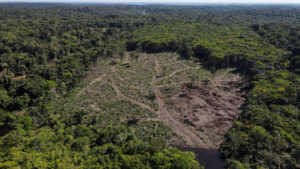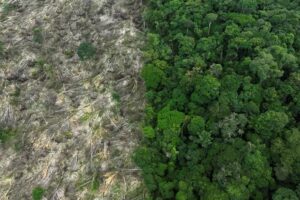The Amazon Rainforest, considered the lungs of the planet, is facing an unprecedented environmental crisis due to gold mining, which threatens to turn it into a desert. This activity has transformed vast expanses of jungle into arid and sterile landscapes, similar to a desert. In the last two decades, deforestation and soil degradation have increased dramatically, affecting the biodiversity and ecosystems of the region.
The impact of gold mining in the Amazon goes beyond the loss of trees. The extraction of the mineral destroys the top layer of soil, known as “topsoil,” which is essential for fertility and water retention. Without this layer, the soil loses its ability to regenerate and sustain life. Furthermore, mercury contamination and other chemicals affect water quality and jeopardize the health of local communities.
It is estimated that by 2023, around 1.3 million hectares of the Amazon basin were impacted by mining. This activity has also encroached on indigenous territories, leading to social conflicts and affecting over 34 million people, including 2.7 million indigenous individuals from 511 different groups.
To control illegal mining, several governments in the region have established mining corridors where gold extraction is allowed in a formal manner. However, the lack of regulations and supervision has allowed the activity to continue without adequate environmental controls. In many cases, legal and illegal mining coexist, exacerbating deforestation, pollution, and biodiversity loss.

Alternatives for Restoration and Mitigation to Prevent the Amazon from Becoming a Desert
Despite the serious environmental damage, there are solutions to reverse this situation. One of them is ecological restoration, which includes reintroducing native species capable of restoring soil fertility. Biotechnology techniques have also been developed to enhance the soil’s ability to absorb nutrients and reduce pollution.
Another alternative is the adoption of sustainable practices such as agroecology and agroforestry. These strategies allow for the utilization of jungle resources without destroying it, promoting economic development that benefits both the local population and the environment.
Gold mining in the Amazon is transforming the jungle into a desert. However, there is still time to reverse this process. The implementation of stricter regulations, along with the promotion of sustainable activities, can make a difference. Restoring the Amazon is a challenge that requires international cooperation and regional commitment, but with coordinated efforts, it is possible to bring life back to this vital ecosystem for the planet.

Characteristics of the Amazon
The Amazon is a region in South America characterized by:
- Geographical features: It spans nine South American countries and covers an area of 7 million square kilometers. Brazil and Peru are the countries with the largest extensions of the Amazon. In fact, the Pico da Neblina in Brazil is the highest point in the Amazon, at 2995 meters above sea level.
- Biological characteristics: It is a rich and diverse biological reservoir, home to millions of species of plants, insects, birds, and other animals. Among the animals inhabiting the Amazon are the jaguar, the pink dolphin, the hyacinth macaw, and the poison dart frog. Mountain refuges are one of the most biodiverse places in the Amazon.
- Ecological characteristics: It is essential for life on the planet, providing fundamental ecosystem services and helping mitigate climate change by stabilizing rainfall patterns and storing large amounts of carbon.
- Threats: Expansion of agriculture, industrial farming, urban sprawl, mining, oil extraction, dams, and logging are the main threats to this ecosystem.
Source: Roosevelt García-Villacorta/Latinoamérica21
Have you visited our YouTube channel? Subscribe!

